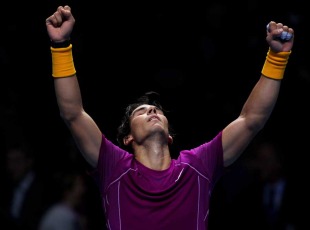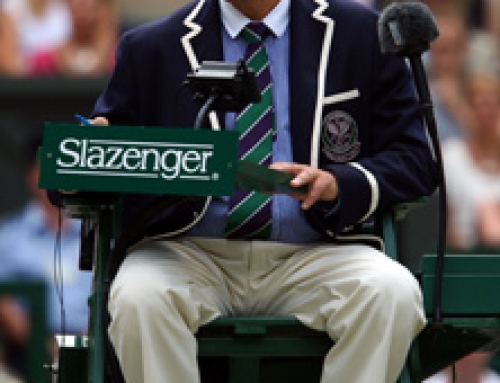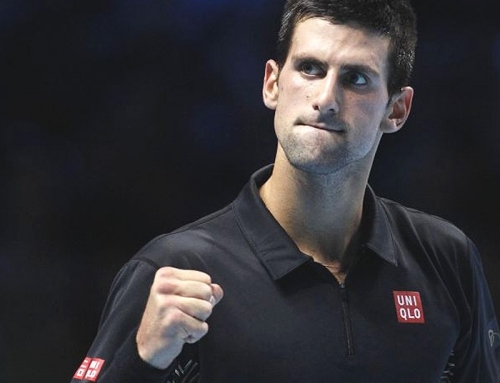 When the world’s best play one another, you hope, nay, you expect to see great matches.
When the world’s best play one another, you hope, nay, you expect to see great matches.
The ATP World Tour Finals gather the best 8 players in the world where the winner must play up to 5 different top 8 players to win.
There were opportunities for greatness to happen. Roger Federer played Andy Murray in the second of three round-robin matches. That turned out to be a dud as Murray struggled with form throughout, and served abysmally low first serves and made errors galore. It was fortunate that Murray’s form improved significantly against weaker competition, i.e., David Ferrer, which allowed him to get to the semis.
For a while, Djokovic-Nadal looked to be the match of the tournament. Djokovic was striking the ball well. Nadal looked a bit rusty in his victory over Andy Roddick. And for a while, this was indeed close until Djokovic ran into another bit of weirdness in his history of health issues. This time, something irritated his contact lens, and he was not quite the same after that, yielding the last few games of the first set and the rest of the second set easily.
Even Djokovic-Roddick had some intrigue. Roddick had recently done better against Djokovic, though, to be fair, he hadn’t played Djokovic at his best, and some of these victories came amidst heat, which Djokovic is know for being less than stalwart against. But it didn’t turn out that way. Djokovic steamrolled to the first set. Roddick probably knew that if he didn’t win in straight sets, he was out of the tournament, and so his enthusiasm dipped as well, and he nary put up a real fight the rest of the way.
It was hoped, with 4 of the top 5 players (Murray was ranked 5 due to a last minute surge by Robin Soderling in Paris that moved him ahead of Murray in the rankings), the semifinal day would provide some sizzle.
And indeed, it did.
If you’ve been hiding under a rock for a year or so, you may not have noticed Rafa’s recent rededication to playing more aggressive tennis. The first signs of this came during Doha, when Rafa made the finals, took a 6-0 first set over then, very hot Nikolay Davydenko, only to find the resourceful Russian keep even in the second set, then fend off match points to take the second set. Rafa would get an early break in the third set, but the Russian fought hard, and not only got back one break, but a second. Rafa must have been devasted.
Rafa had to retire against Andy Murray in the Aussie Open and took some time off. By the time he reached Indian Wells, a surprising Ivan Ljubicic came back to win his semi in 3 sets, then Roddick achieved the same feat in Miami. Rafa would need the friendly confines of European clay to reinvigorate a man who had been questioning his own ability to close out matches.
Rafa’s newfound aggression is meant to preserve his body. Too often, Rafa would play spinny shots up the middle and let his opponents make mistake as he chased down ball after ball. Being maybe the quickest guy on tour, Rafa can afford a lack of aggression. This doesn’t mean Rafa is never aggressive, but he often has to be backed into a corner before he tries taking a big shot.
Over the years, Rafa’s opponents have had to employ “The Rafa Strategy”. The player that most notably does this is Andy Murray. More known for a passive style of play, Murray knows he has to up the level of aggression if he wants to keep up with Rafa. Rafa can take the most neutral of balls and punish it to either sideline. His ability to pick either sideline means a player can struggle mightily just to reach the ball (the women don’t have this problem–a Rafa-like shot in the women’s game would be a winner–no woman is fast enough to chase down the hardest hit shots).
Witness Rafa’s match against Roddick. Time and again, Roddick would barely get to a ball and try to do something to keep him in the point. However, in such dire straits, Roddick was unable to go for big shots, and would often loop the ball to buy time. Today’s best players, alas, can eat a high moonball for lunch and go for winners. This includes Rafa, by the way.
Nadal opened the match by playing aggressive ball, trying to push Murray around. This was mostly successful, at least on his own serve. Murray had to rely on some big serving. As usual, his first serve percentage was dismal, but he hit over 20 aces throughout the match.
Down a set, it seemed like Murray might go away, but he managed to stay in the set, and then suddenly achieve a break, and then another break. Rafa seemed surprised at Murray’s aggression. Although people are loathe to say it, you can rattle Rafa. Sometimes, when he feels like he’s being attacked, he’ll go into a shell. Instead of attacking the ball, he starts spinning it safely up the middle. Murray was making Rafa run, and although both men are in great shape, it may be the slightest glimmer of fatigue was making Rafa nervous.
Although Murray concluded the second set with a second break, he wasn’t able to make the best of his opportunity in the second set. Indeed, on a crucial point, he decided to play a drop shot, despite Nadal having had good luck chasing it down. Nadal chased it down, whipped an angle shot, barely out of the reach of Murray’s outstretched arms.
And suddenly Murray was down a break. And he would stay down a break despite having chances to come back until the very last game when, needing to break Nadal or go home, Murray returned a short ball at break point. Rafa hit the shot crosscourt to Murray’s backhand, and Murray threaded the needle to get the break back. 5-all.
The two would head into a tiebreak where Murray would take a 2-0 lead then a 4-1 leads.
But here’s the dilemma. Rafa was, by this point, playing rather conservative ball. Do you decide to go for big shots and possibly make an error (Murray had nearly 50 errors in this match) or do you try to goad Nadal, the steadiest player in the game, into an error. Murray knew that aggressive play got him in the game, and so aggressive play was what he needed, but with Rafa afraid to pull the trigger, Murray felt he could trade a few shots while looking for that opening.
In a way, Rafa played a little possum. He knew Murray would want to jump at opportunities and possibly make errors, but if Rafa could go for his shots at the right time, Murray might not be ready to deal with a hard hit surprise shot.
In the end, Rafa took some chances, played a few big points, and Murray, in the best match of the week, came oh-so-close, but in second place once again.
Final score: 7-6(5), 3-6, 7-6(6).
Now to see if Djokovic can put up a fight and make the second match just as interesting.



![[WTF] Djokovic wins third year-end title with straight set win over Nadal](https://www.essentialtennis.com/wp-content/uploads/2013/11/20131111nole-500x383.jpg)
![[WTF] Djokovic defeats Federer in round robin play](https://www.essentialtennis.com/wp-content/uploads/2013/11/20131105djo-500x383.jpg)


![[World Tour Finals, Semis] Djokovic and Federer to meet in the finals](https://www.essentialtennis.com/wp-content/uploads/2012/11/20121110fed-500x383.jpg)